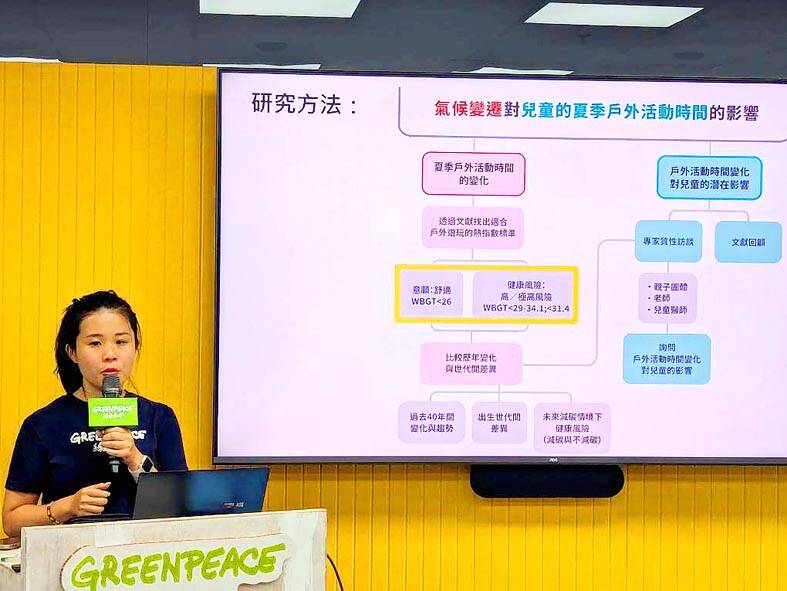The government should improve children’s outdoor spaces and accelerate carbon reduction programs, as the risk of heat-related injury due to high summer temperatures rises each year, Greenpeace told a news conference yesterday.
Greenpeace examined summer temperatures in Taipei, New Taipei City, Taoyuan, Hsinchu City, Taichung, Tainan and Kaohsiung to determine the effects of high temperatures and climate change on children’s outdoor activities, citing data garnered by China Medical University, which defines a wet-bulb globe temperature (WBGT) of 29°C or higher as posing the risk of heat-related injury.
According to the Central Weather Administration, WBGT, commonly referred to as the heat index, estimates the effect of heat stress on humans by combining temperature, humidity, wind speed, sun angle and cloud cover.

Photo: CNA
Greenpeace said that in the summer of 2023, there were 780 hours of heat-related injury risk, up 213 hours from the previous year.
If no aggressive carbon reduction measures are taken and global temperatures rise by 4°C, the number could rise to 1,193 hours by 2100, it said.
That would mean more than half of the summer would pose the risk of heat-related harm, it said.
Wang Hsiu-chuan (王秀娟), chair of Taiwan Parks and Playgrounds for Children by Children, said that a heat test at a park in May last year found that natural loose surface coverings such as bark or wood chips, and shaded areas helped to reduce heat-related risks.
The Ministry of Health and Welfare and local governments should establish concrete plans for cooling, dissipating heat and setting shade ratios at parks and playgrounds, Wang said.
The government should accelerate carbon reduction and energy transition plans, and consider children’s needs when setting carbon reduction targets, Greenpeace said.
The government should also improve children’s outdoor spaces by adding shade, sprinklers and water play areas, as well as heat injury warnings and emergency medical equipment, it said.
It should provide families with subsidies during high temperatures, including for public transportation, it added.
The Ministry of Environment is developing a “cool map” to identify outdoor shaded areas and indoor cool spots, such as parks with good tree cover, places with splash pools or facilities with cooling systems, Climate Change Administration Director-General Tsai Lin-yi (蔡玲儀) said.
The Ministry of Environment is exploring how to use natural methods and environmental design to reduce temperatures and improve outdoor conditions for children, and would develop guidelines for local governments, Tsai said.

US climber Alex Honnold is to attempt to scale Taipei 101 without a rope and harness in a live Netflix special on Jan. 24, the streaming platform announced on Wednesday. Accounting for the time difference, the two-hour broadcast of Honnold’s climb, called Skyscraper Live, is to air on Jan. 23 in the US, Netflix said in a statement. Honnold, 40, was the first person ever to free solo climb the 900m El Capitan rock formation in Yosemite National Park — a feat that was recorded and later made into the 2018 documentary film Free Solo. Netflix previewed Skyscraper Live in October, after videos

NUMBERS IMBALANCE: More than 4 million Taiwanese have visited China this year, while only about half a million Chinese have visited here Beijing has yet to respond to Taiwan’s requests for negotiation over matters related to the recovery of cross-strait tourism, the Tourism Administration said yesterday. Taiwan’s tourism authority issued the statement after Chinese-language daily the China Times reported yesterday that the government’s policy of banning group tours to China does not stop Taiwanese from visiting the country. As of October, more than 4.2 million had traveled to China this year, exceeding last year. Beijing estimated the number of Taiwanese tourists in China could reach 4.5 million this year. By contrast, only 500,000 Chinese tourists are expected in Taiwan, the report said. The report

Temperatures are forecast to drop steadily as a continental cold air mass moves across Taiwan, with some areas also likely to see heavy rainfall, the Central Weather Administration (CWA) said. From today through early tomorrow, a cold air mass would keep temperatures low across central and northern Taiwan, and the eastern half of Taiwan proper, with isolated brief showers forecast along Keelung’s north coast, Taipei and New Taipei City’s mountainous areas and eastern Taiwan, it said. Lows of 11°C to 15°C are forecast in central and northern Taiwan, Yilan County, and the outlying Kinmen and Lienchiang (Matsu) counties, and 14°C to 17°C

STEERING FAILURE: The first boat of its class is experiencing teething issues as it readies for acceptance by the navy, according to a recent story about rudder failure The Hai Kun (海鯤), the nation’s first locally built submarine, allegedly suffered a total failure of stern hydraulic systems during the second round of sea acceptance trials on June 26, and sailors were forced to manually operate the X-rudder to turn the submarine and return to port, news Web site Mirror Daily reported yesterday. The report said that tugboats following the Hai Kun assisted the submarine in avoiding collisions with other ships due to the X-rudder malfunctioning. At the time of the report, the submarine had completed its trials and was scheduled to begin diving and surfacing tests in shallow areas. The X-rudder,